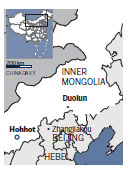Local tourism, environment, weather benefit from increased tree planting
Visitors may find it hard to imagine that the beautiful scenery along a scenic road in Zhangbei county in Zhangjiakou, North China's Hebei province, was once only weeds on barren mountains.
Dubbed "China's Route 66", the road is lined with high grass and trees on both sides, offering beautiful vistas for road trippers.
The road, which connects Zhangbei and Chongli, a ski venue for the 2022 Winter Olympics, attracted more than 330,000 travelers last year, according to the Zhangbei Tourism Bureau.
During the peak visitor time in summer, the daily vehicle flow can reach 6,000.
However, few know how the road came into existence.
Wang Jinhuan, deputy head of the Zhangbei Forestry Administration, said there was no road in that area before 2000.
"At that time, all people could see were barren mountains," Wang said.
The mountains were covered with weeds and no plants or trees, because the land was dry and nobody cared about how it looked like, Wang said.
As a worker who has been engaged in greening work in Zhangbei for more than 20 years, Wang said he once hoped the mountains could be planted with trees which would be beautiful and attractive, but he felt alone in those hopes.
In 2000, however, people started to realize it was not only the appearance of the desolate area that really mattered.
In the spring of that year, 12 sandstorms of various scale and strength struck the country's northern areas, which include Zhangjiakou.
To prevent more sandstorms, China launched a massive afforestation program that year.
Zhangjiakou was one of the areas ordered to plant trees on land that was under threat of desertification.
"Since then, people started to plant trees on the barren mountains," Wang said, adding that the planters' feet and vehicle wheels left a path - the road's initial stage.
Large areas were being afforested each year.
With more than 33,000 hectares of plants and trees planted in the following decade, the track was extended to 133 kilometers. The long path with beautiful scenery alongside attracted more and more people to go sightseeing.
Local residents and travelers from surrounding cities including Beijing and Tianjin often take road trips to Zhangjiakou on summer weekends, as the temperatures in the area are much cooler.
The road was paved in 2012 when the local government realized it was becoming a scenic spot.
"That is its history," Wang said, as he referred to himself as a witness who saw the gradual transformation of the road.
"My hope has become true thanks to the afforestation program. Now some little children even wonder what sandstorms are because the phenomenon has become rare."
The change in Zhangbei is a prototype of the country's overall greening program. From 2000 to 2012, trees were planted on a combined area of 7.5 million hectares in Beijing,
Some areas of Tianjin and the provinces of Hebei and Shanxi and the Inner Mongolia autonomous region, are considered the sources of sandstorms, according to the State Forestry Administration. Large-scale afforestation schemes have shown results, and sandstorms have been noticeably weakened.
Beijing, for example, averaged 12 sandstorms each year from 2000 to 2002. In 2010, the number of such storms reduced to four, with only three in 2011 and two in 2012.
The capital city experienced no sandstorms in 2014. From 2013 through 2022, it is planned to plant another 5.9 million hectares of land in those regions and Shaanxi province with trees.
zhangyu@chinadaily.com.cn

(China Daily 06/17/2016 page12)








